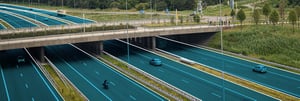
Frequently Asked Questions
Why INSPECH Assessment
- An Inspector drives a vehicle fitted with a Hi-Res, GPS powered camera to capture video footage of the road surface.
- The footage is then imported to INSPECH and displayed on digital maps. By visualizing detailed road surface images and road sections, a digital twin of the road network is provided.
- An inspector can then mark road distresses manually or with AI assistance. The available reporting and charting capabilities enable assessment of the pavement condition, thereby assisting with maintenance planning.
- An inspector can then publish the inspection to the end client, so that the inspection can be viewed, used interactively, or downloaded.
INSPECH Assessment is designed by road engineers for road engineers, whom are typically contracted by national or local highways authorities, to undertake pavement condition assessments. These companies are usually INSPECH Partners.
By default, the road condition calculation takes the most important visual distress types into account (Longitudinal Cracking, Transverse Cracking, Alligator Cracking and Potholes). Other visual distress types as defined by the PCI standard for Asphalt will be added (coming soon).
The main cost saving is in speeding up the process of inspecting a road, generating a road inspection report, and sharing this with clients. By using AI assisted distress annotation, the human effort is reduced and the accuracy is increased.
- FASTER
Up to 5 times shorter inspection time per kilometre road; - BETTER USER EXPERIENCE
For inspectors, an efficient workflow; For clients, actionable and interactive insights; - RECURRING BUSINESS
Since clients use the same platform, any request for add-on reporting or follow-up is easy to process and provide; - CHEAPER
No CAPEX (no IT infrastructure required). Low cost entry point (pay monthly) and no software maintenance (Fully SaaS); - CONSISTENCY
AI Assisted road inspections make for more consistency over time and across inspectors.
Artificial Intelligence (AI)
Scanning
With GoPro 10 and upwards, the workflow is extra efficient: you can simply import the raw video files. INSPECH Assessment will extract the images for you and plot everything on the map.
Data
In short, we need geo-referenced images: JPG, PNG or TIFF images where each pixel is referencing a certain place on earth. Typically, geo-referenced images can be generated from available GPS or, chainage data together with the image data.
Alternatively, we accept raw GoPro 10+ video files, for automated image abstraction.
When you face difficulties to meet the above data requirements, do not hesitate to contact us. We have seen many different input formats and might be able to help.
Inspection reports
INSPECH Assessment uses visual inspections only, meaning the identification of distresses is from images acquired by cameras.
By nature, the inspections are detailed visual inspections. You can use the inspection data as input for global (a.k.a. coarse) visual inspections as well.
Since we offer a SaaS product, the best way to consume a report is the browser based, interactive view of your data. Using the application, you have all viewing, sorting and filtering capabilities at your disposal, and you have full power over who you wish to share it with. Feel free to schedule a non-committal demonstration here.
Next to that, we offer Excel and Shapefile export formats.
Plans and subscriptions
First, the Base subscription is FIXED at € 11,988 for an annual subscription for 500km/lanes of inspections. This can be paid monthly.
Second, if you need more than 500km/lanes capacity, then a tiered pricing is applied which gives a lower unit price for more km/lane volume.
Third, if you want to add AI assistance to your capability, then a tiered pricing is applied for this also. This must match the total Km/lane commitment for the subscription.
Growth can be added to the subscription at any time as required.
You can optionally choose to free up data storage by deleting inspection projects. However, one of the advantages of working with INSPECH is that inspections can be compared with each other to gain insight into the deterioration of the road surface within a certain period. By deleting inspections to free up data storage, you also remove the historical context that is required for these comparisons.
